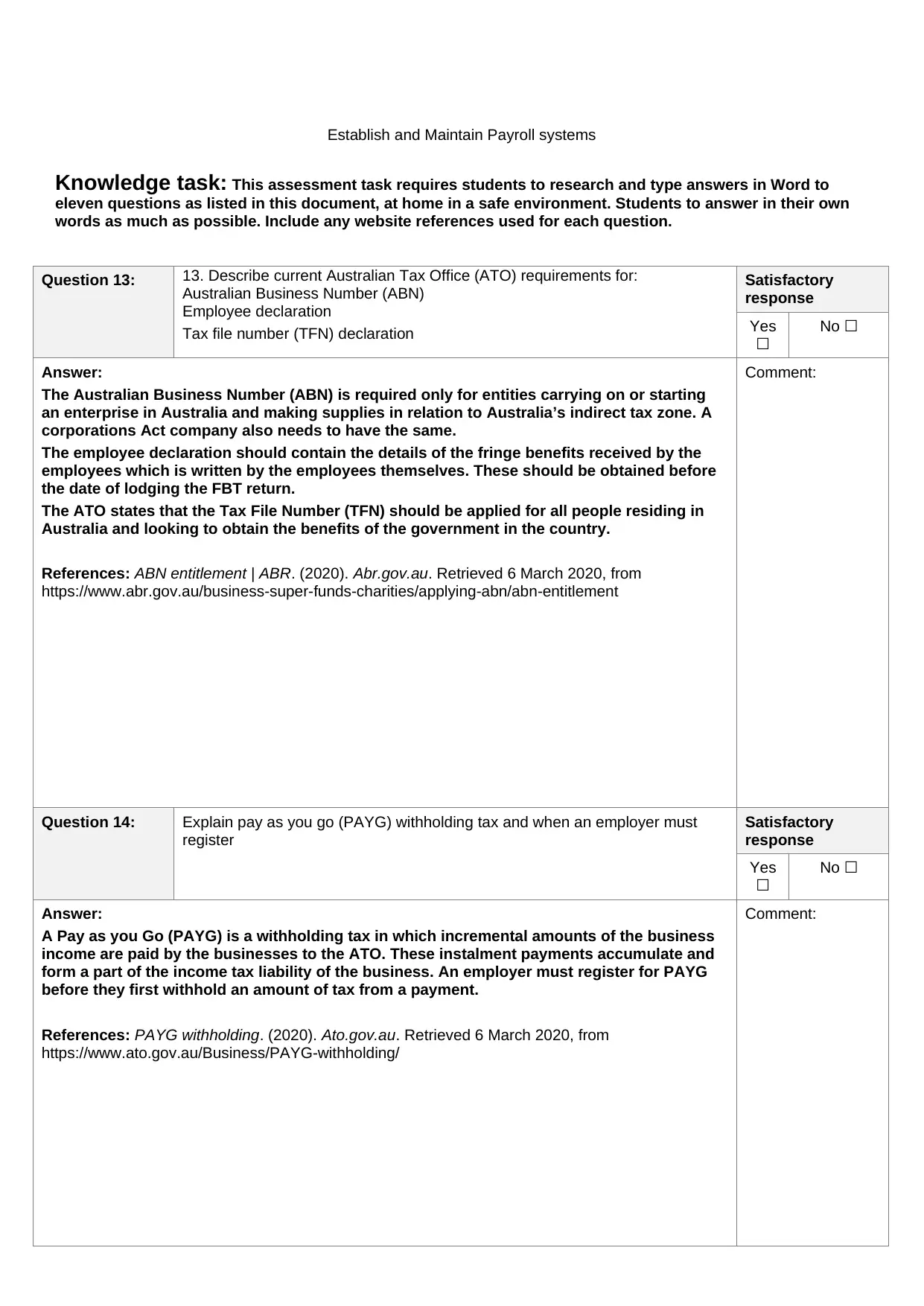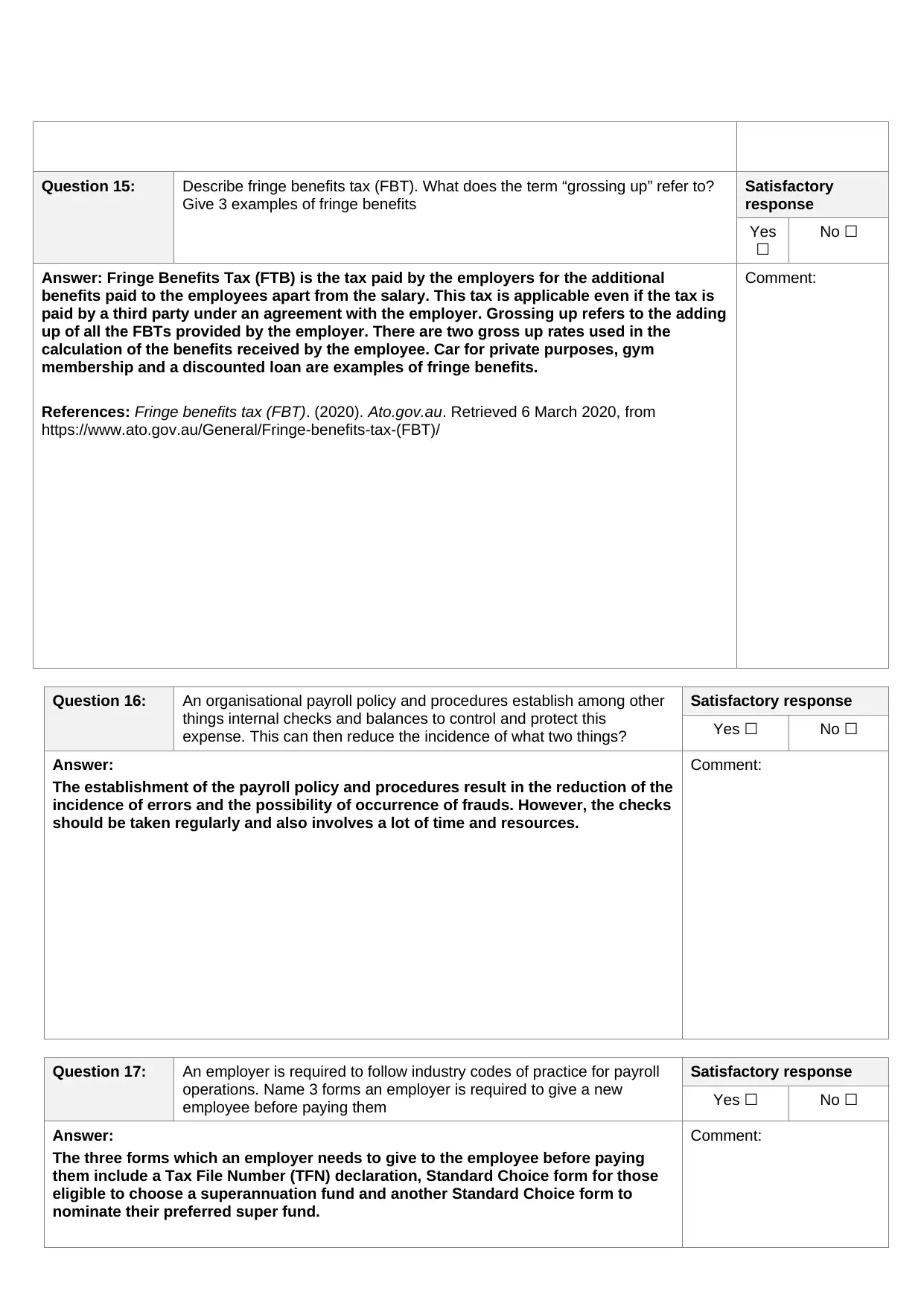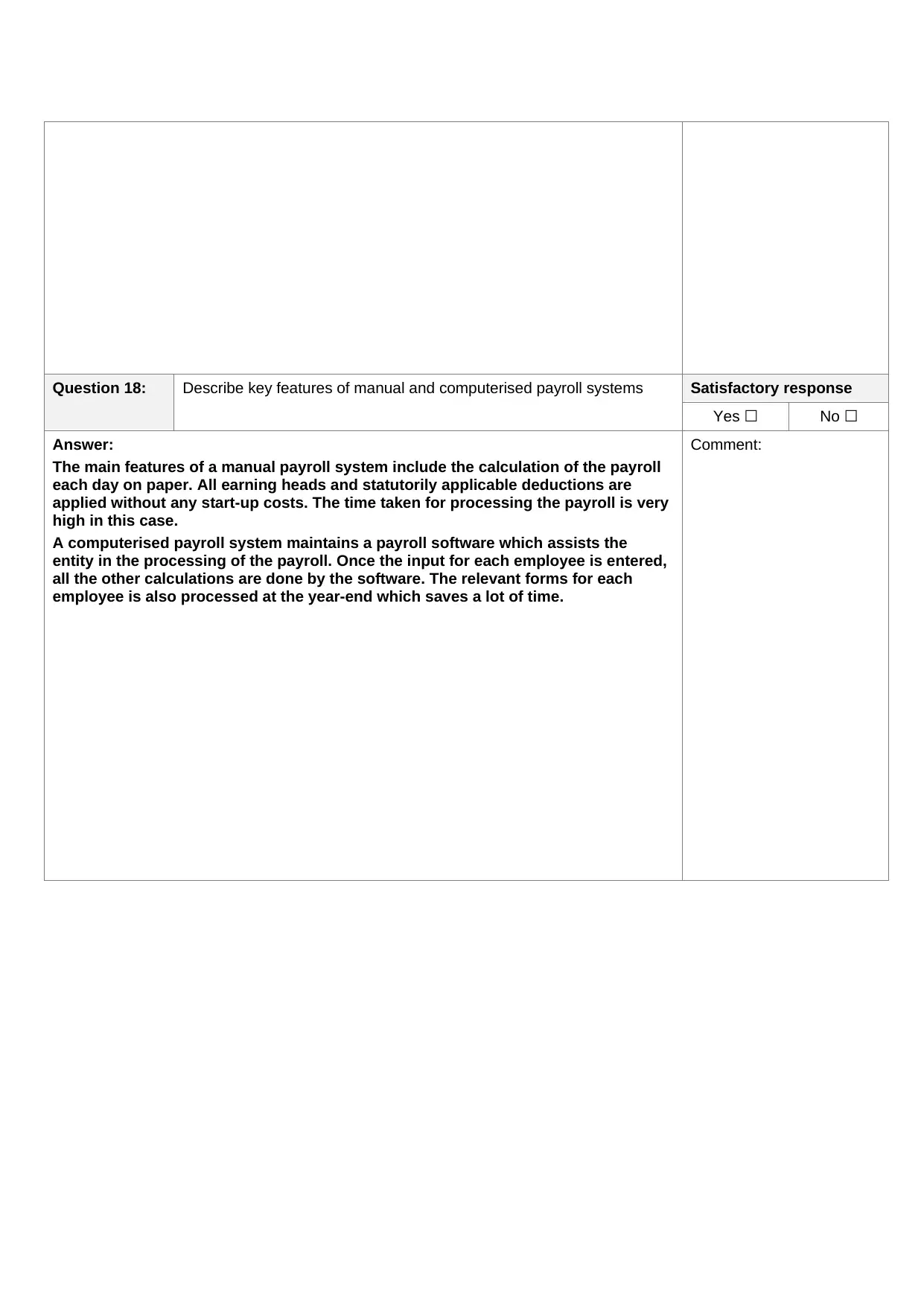Establish and Maintain Payroll systems | Assessment
VerifiedAdded on 2022/08/16
|6
|1487
|11
AI Summary
Contribute Materials
Your contribution can guide someone’s learning journey. Share your
documents today.

Establish and Maintain Payroll systems
Knowledge task: This assessment task requires students to research and type answers in Word to
eleven questions as listed in this document, at home in a safe environment. Students to answer in their own
words as much as possible. Include any website references used for each question.
Question 13: 13. Describe current Australian Tax Office (ATO) requirements for:
Australian Business Number (ABN)
Employee declaration
Tax file number (TFN) declaration
Satisfactory
response
Yes
☐
No ☐
Answer:
The Australian Business Number (ABN) is required only for entities carrying on or starting
an enterprise in Australia and making supplies in relation to Australia’s indirect tax zone. A
corporations Act company also needs to have the same.
The employee declaration should contain the details of the fringe benefits received by the
employees which is written by the employees themselves. These should be obtained before
the date of lodging the FBT return.
The ATO states that the Tax File Number (TFN) should be applied for all people residing in
Australia and looking to obtain the benefits of the government in the country.
References: ABN entitlement | ABR. (2020). Abr.gov.au. Retrieved 6 March 2020, from
https://www.abr.gov.au/business-super-funds-charities/applying-abn/abn-entitlement
Comment:
Question 14: Explain pay as you go (PAYG) withholding tax and when an employer must
register
Satisfactory
response
Yes
☐
No ☐
Answer:
A Pay as you Go (PAYG) is a withholding tax in which incremental amounts of the business
income are paid by the businesses to the ATO. These instalment payments accumulate and
form a part of the income tax liability of the business. An employer must register for PAYG
before they first withhold an amount of tax from a payment.
References: PAYG withholding. (2020). Ato.gov.au. Retrieved 6 March 2020, from
https://www.ato.gov.au/Business/PAYG-withholding/
Comment:
Knowledge task: This assessment task requires students to research and type answers in Word to
eleven questions as listed in this document, at home in a safe environment. Students to answer in their own
words as much as possible. Include any website references used for each question.
Question 13: 13. Describe current Australian Tax Office (ATO) requirements for:
Australian Business Number (ABN)
Employee declaration
Tax file number (TFN) declaration
Satisfactory
response
Yes
☐
No ☐
Answer:
The Australian Business Number (ABN) is required only for entities carrying on or starting
an enterprise in Australia and making supplies in relation to Australia’s indirect tax zone. A
corporations Act company also needs to have the same.
The employee declaration should contain the details of the fringe benefits received by the
employees which is written by the employees themselves. These should be obtained before
the date of lodging the FBT return.
The ATO states that the Tax File Number (TFN) should be applied for all people residing in
Australia and looking to obtain the benefits of the government in the country.
References: ABN entitlement | ABR. (2020). Abr.gov.au. Retrieved 6 March 2020, from
https://www.abr.gov.au/business-super-funds-charities/applying-abn/abn-entitlement
Comment:
Question 14: Explain pay as you go (PAYG) withholding tax and when an employer must
register
Satisfactory
response
Yes
☐
No ☐
Answer:
A Pay as you Go (PAYG) is a withholding tax in which incremental amounts of the business
income are paid by the businesses to the ATO. These instalment payments accumulate and
form a part of the income tax liability of the business. An employer must register for PAYG
before they first withhold an amount of tax from a payment.
References: PAYG withholding. (2020). Ato.gov.au. Retrieved 6 March 2020, from
https://www.ato.gov.au/Business/PAYG-withholding/
Comment:
Secure Best Marks with AI Grader
Need help grading? Try our AI Grader for instant feedback on your assignments.

Question 15: Describe fringe benefits tax (FBT). What does the term “grossing up” refer to?
Give 3 examples of fringe benefits
Satisfactory
response
Yes
☐
No ☐
Answer: Fringe Benefits Tax (FTB) is the tax paid by the employers for the additional
benefits paid to the employees apart from the salary. This tax is applicable even if the tax is
paid by a third party under an agreement with the employer. Grossing up refers to the adding
up of all the FBTs provided by the employer. There are two gross up rates used in the
calculation of the benefits received by the employee. Car for private purposes, gym
membership and a discounted loan are examples of fringe benefits.
References: Fringe benefits tax (FBT). (2020). Ato.gov.au. Retrieved 6 March 2020, from
https://www.ato.gov.au/General/Fringe-benefits-tax-(FBT)/
Comment:
Question 16: An organisational payroll policy and procedures establish among other
things internal checks and balances to control and protect this
expense. This can then reduce the incidence of what two things?
Satisfactory response
Yes ☐ No ☐
Answer:
The establishment of the payroll policy and procedures result in the reduction of the
incidence of errors and the possibility of occurrence of frauds. However, the checks
should be taken regularly and also involves a lot of time and resources.
Comment:
Question 17: An employer is required to follow industry codes of practice for payroll
operations. Name 3 forms an employer is required to give a new
employee before paying them
Satisfactory response
Yes ☐ No ☐
Answer:
The three forms which an employer needs to give to the employee before paying
them include a Tax File Number (TFN) declaration, Standard Choice form for those
eligible to choose a superannuation fund and another Standard Choice form to
nominate their preferred super fund.
Comment:
Give 3 examples of fringe benefits
Satisfactory
response
Yes
☐
No ☐
Answer: Fringe Benefits Tax (FTB) is the tax paid by the employers for the additional
benefits paid to the employees apart from the salary. This tax is applicable even if the tax is
paid by a third party under an agreement with the employer. Grossing up refers to the adding
up of all the FBTs provided by the employer. There are two gross up rates used in the
calculation of the benefits received by the employee. Car for private purposes, gym
membership and a discounted loan are examples of fringe benefits.
References: Fringe benefits tax (FBT). (2020). Ato.gov.au. Retrieved 6 March 2020, from
https://www.ato.gov.au/General/Fringe-benefits-tax-(FBT)/
Comment:
Question 16: An organisational payroll policy and procedures establish among other
things internal checks and balances to control and protect this
expense. This can then reduce the incidence of what two things?
Satisfactory response
Yes ☐ No ☐
Answer:
The establishment of the payroll policy and procedures result in the reduction of the
incidence of errors and the possibility of occurrence of frauds. However, the checks
should be taken regularly and also involves a lot of time and resources.
Comment:
Question 17: An employer is required to follow industry codes of practice for payroll
operations. Name 3 forms an employer is required to give a new
employee before paying them
Satisfactory response
Yes ☐ No ☐
Answer:
The three forms which an employer needs to give to the employee before paying
them include a Tax File Number (TFN) declaration, Standard Choice form for those
eligible to choose a superannuation fund and another Standard Choice form to
nominate their preferred super fund.
Comment:

Question 18: Describe key features of manual and computerised payroll systems Satisfactory response
Yes ☐ No ☐
Answer:
The main features of a manual payroll system include the calculation of the payroll
each day on paper. All earning heads and statutorily applicable deductions are
applied without any start-up costs. The time taken for processing the payroll is very
high in this case.
A computerised payroll system maintains a payroll software which assists the
entity in the processing of the payroll. Once the input for each employee is entered,
all the other calculations are done by the software. The relevant forms for each
employee is also processed at the year-end which saves a lot of time.
Comment:
Yes ☐ No ☐
Answer:
The main features of a manual payroll system include the calculation of the payroll
each day on paper. All earning heads and statutorily applicable deductions are
applied without any start-up costs. The time taken for processing the payroll is very
high in this case.
A computerised payroll system maintains a payroll software which assists the
entity in the processing of the payroll. Once the input for each employee is entered,
all the other calculations are done by the software. The relevant forms for each
employee is also processed at the year-end which saves a lot of time.
Comment:

Question 19: Refer to Unit 7 of your textbook. Name the 4 types of payment summary. Name
the document issued by My gov if an employer is using Single Touch Payroll.
Satisfactory
response
Yes
☐
No ☐
Answer: The four types of payment summaries are the payment summaries for workers,
electronic payment summaries, part-year payment summaries and paper payment
summaries. If an employer is using the single touch payroll, then Mygov will send a tax and
super information related document.
References: PAYG payment summaries. (2020). Ato.gov.au. Retrieved 6 March 2020, from
https://www.ato.gov.au/business/payg-withholding/payg-payment-summaries/
Comment:
Question 20: Define an employment termination payment (ETP), including 3 examples of an
ETP
Satisfactory
response
Yes
☐
No ☐
Answer:
An employment termination payment (ETP) is a payment received by the employee on the
completion of their employment tenure. Some of the examples of ETP include payments for
unused leave or unused roster days off, payments in lieu of notice and compensation for
loss of job or wrongful dismissal of the employee.
References: Employment termination payments. (2020). Ato.gov.au. Retrieved 6 March 2020,
from https://www.ato.gov.au/Individuals/Working/Working-as-an-employee/Leaving-your-job/
Employment-termination-payments/
Comment:
Question 21: Go to www.tpb.gov.au and list 5 different categories of the code of professional
conduct for BAS agents. Give one workplace example of one of the categories
Satisfactory
response
Yes
☐
No ☐
Answer:
The 5 different categories of the code of professional conduct for BAS agents includes
honesty and integrity, independence, confidentiality, competence and other
responsibilities. One of the examples is to act with honesty and integrity if one receives
money or other properties on behalf of a client or hold the money or other related
properties on trust.
Comment:
the document issued by My gov if an employer is using Single Touch Payroll.
Satisfactory
response
Yes
☐
No ☐
Answer: The four types of payment summaries are the payment summaries for workers,
electronic payment summaries, part-year payment summaries and paper payment
summaries. If an employer is using the single touch payroll, then Mygov will send a tax and
super information related document.
References: PAYG payment summaries. (2020). Ato.gov.au. Retrieved 6 March 2020, from
https://www.ato.gov.au/business/payg-withholding/payg-payment-summaries/
Comment:
Question 20: Define an employment termination payment (ETP), including 3 examples of an
ETP
Satisfactory
response
Yes
☐
No ☐
Answer:
An employment termination payment (ETP) is a payment received by the employee on the
completion of their employment tenure. Some of the examples of ETP include payments for
unused leave or unused roster days off, payments in lieu of notice and compensation for
loss of job or wrongful dismissal of the employee.
References: Employment termination payments. (2020). Ato.gov.au. Retrieved 6 March 2020,
from https://www.ato.gov.au/Individuals/Working/Working-as-an-employee/Leaving-your-job/
Employment-termination-payments/
Comment:
Question 21: Go to www.tpb.gov.au and list 5 different categories of the code of professional
conduct for BAS agents. Give one workplace example of one of the categories
Satisfactory
response
Yes
☐
No ☐
Answer:
The 5 different categories of the code of professional conduct for BAS agents includes
honesty and integrity, independence, confidentiality, competence and other
responsibilities. One of the examples is to act with honesty and integrity if one receives
money or other properties on behalf of a client or hold the money or other related
properties on trust.
Comment:
Secure Best Marks with AI Grader
Need help grading? Try our AI Grader for instant feedback on your assignments.

References: Code of Professional Conduct for BAS agents | TPB. (2020). Tpb.gov.au. Retrieved
6 March 2020, from https://www.tpb.gov.au/code-professional-conduct-bas-agents
6 March 2020, from https://www.tpb.gov.au/code-professional-conduct-bas-agents

Question
22:
Define pay as you go instalment (PAYGI) tax
Define pay as you go withholding (PAYGW) tax
Satisfactory
response
Yes
☐
No ☐
Answer: PAYG instalment tax is a system where the taxpayer makes regular payments
towards their estimated annual tax liability. This is applicable only for taxpayers who
earn business or investment income over the stipulated limit.
The Pay as you go withholding (PAYG) is a tax on which the business needs to pay
incremental amounts of one’s business income to the ATO. These payments are
accumulated together to form a part of the year ending income tax liability of the
individual paying the taxes. The PAYG instalments need to be finalised before the
lodging of the income tax return of the individual.
Comment:
Question
23:
Describe superannuation guarantee and superannuation guarantee charge Satisfactory
response
Yes
☐
No ☐
Answer: As a part of the terms and conditions of the employment, an employer needs to
deposit a fixed amount into the selected superannuation fund of the employer. This is
known as the superannuation guarantee. In this case, the super rate which is used in the
calculation of the employee contribution is determined on the basis of the ordinary
wages, payments, bonuses and commissions of the employees.
The superannuation charge is the penalty which the employer will have to pay
the ATO if they fail to pay the superannuation guarantee to the recognised
superannuation fund on a previously agreed date. These charges are further divided into
three categories which include the super guarantee shortfall amounts, nominal interest
on the amounts and the administration fee related to the same.
References:
The super guarantee charge (SGC). (2020). Ato.gov.au. Retrieved 6 March 2020, from
https://www.ato.gov.au/business/super-for-employers/paying-super-contributions/
missed-and-late-payments/the-super-guarantee-charge-(sgc)/
22:
Define pay as you go instalment (PAYGI) tax
Define pay as you go withholding (PAYGW) tax
Satisfactory
response
Yes
☐
No ☐
Answer: PAYG instalment tax is a system where the taxpayer makes regular payments
towards their estimated annual tax liability. This is applicable only for taxpayers who
earn business or investment income over the stipulated limit.
The Pay as you go withholding (PAYG) is a tax on which the business needs to pay
incremental amounts of one’s business income to the ATO. These payments are
accumulated together to form a part of the year ending income tax liability of the
individual paying the taxes. The PAYG instalments need to be finalised before the
lodging of the income tax return of the individual.
Comment:
Question
23:
Describe superannuation guarantee and superannuation guarantee charge Satisfactory
response
Yes
☐
No ☐
Answer: As a part of the terms and conditions of the employment, an employer needs to
deposit a fixed amount into the selected superannuation fund of the employer. This is
known as the superannuation guarantee. In this case, the super rate which is used in the
calculation of the employee contribution is determined on the basis of the ordinary
wages, payments, bonuses and commissions of the employees.
The superannuation charge is the penalty which the employer will have to pay
the ATO if they fail to pay the superannuation guarantee to the recognised
superannuation fund on a previously agreed date. These charges are further divided into
three categories which include the super guarantee shortfall amounts, nominal interest
on the amounts and the administration fee related to the same.
References:
The super guarantee charge (SGC). (2020). Ato.gov.au. Retrieved 6 March 2020, from
https://www.ato.gov.au/business/super-for-employers/paying-super-contributions/
missed-and-late-payments/the-super-guarantee-charge-(sgc)/
1 out of 6
Your All-in-One AI-Powered Toolkit for Academic Success.
+13062052269
info@desklib.com
Available 24*7 on WhatsApp / Email
![[object Object]](/_next/static/media/star-bottom.7253800d.svg)
Unlock your academic potential
© 2024 | Zucol Services PVT LTD | All rights reserved.

